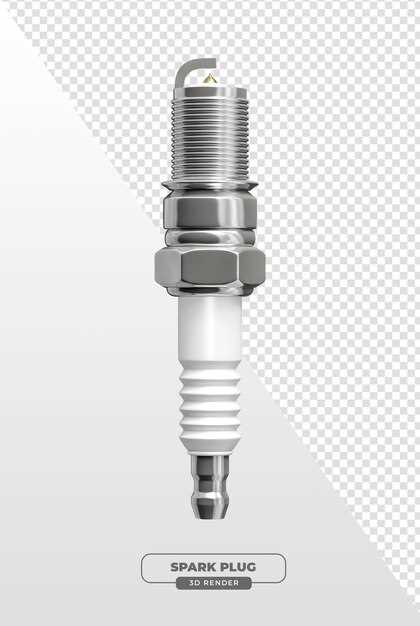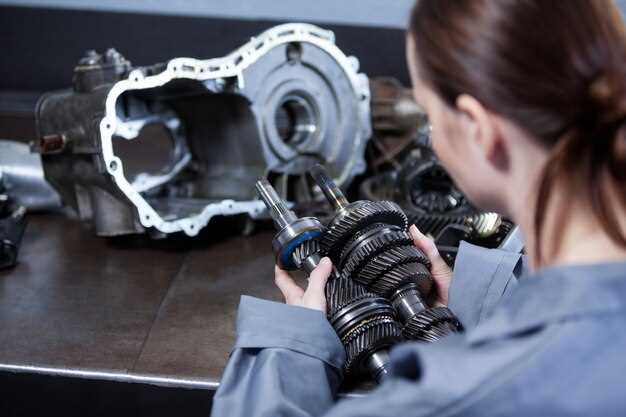
In the intricate world of automotive engineering, spark plugs play a crucial role in the overall performance and efficiency of an engine. These small yet vital components ignite the air-fuel mixture within the combustion chamber, setting off the chain reaction that powers vehicles. However, their influence extends far beyond mere ignition; the condition and type of spark plug in use can significantly affect engine output, fuel consumption, and emissions.
Understanding the Functionality of Spark Plugs is key to appreciating their impact. Spark plugs create a spark that ignites the fuel-air mixture at precisely the right moment. This timing is critical for achieving optimal combustion, which ultimately determines the engine’s efficiency. A well-functioning spark plug will ensure smoother engine operation, while a faulty unit can lead to misfires, reduced power, and increased fuel consumption.
Furthermore, the material and design of spark plugs can also influence engine performance. Various types–such as copper, platinum, and iridium–offer different benefits regarding longevity and heat dissipation. Choosing the right spark plug for a specific engine can enhance efficiency, reduce wear, and even improve overall vehicle lifespan. In this article, we will explore how spark plugs directly impact engine efficiency and what considerations should be taken into account when selecting them.
How Spark Plug Design Influences Fuel Combustion
The design of spark plugs plays a crucial role in influencing fuel combustion efficiency within an internal combustion engine. One of the primary factors is the
Heat range is another vital aspect of spark plug design. Spark plugs are designed to operate within specific temperature ranges. If the heat range is too high, the electrode may overheat, leading to pre-ignition and engine knock. Conversely, a low heat range may cause fouling due to incomplete combustion. Correct heat management ensures optimal combustion and reduces emissions.
The insulator design is equally important. A well-designed insulator helps maintain consistent gap spacing and improves the spark’s effectiveness by preventing voltage leakage. Specialized materials, such as ceramic, can withstand high temperatures and pressures, further enhancing the spark plug’s performance under varying engine conditions.
Electrode gap interplays significantly with efficiency as well. A narrower gap can create a stronger spark, aiding in igniting leaner fuel mixtures, which is increasingly important for modern engines aiming for higher fuel efficiency and reduced emissions. However, this may require precise adjustments and considerations in fuel delivery and ignition timing.
Lastly, the coating and material of the spark plug electrodes can influence fuel combustion as well. Platinum and iridium options enhance durability and performance, leading to more reliable ignition and a stable combustion process. This not only increases engine efficiency but also prolongs the lifespan of the spark plug.
In summary, spark plug design, encompassing aspects such as electrode shape, heat range, insulator construction, gap size, and material choice, significantly impacts fuel combustion efficiency. Understanding these elements can help optimize engine performance and achieve better fuel economy.
Identifying the Right Spark Plug for Your Engine Type
Choosing the appropriate spark plug is crucial for optimizing engine performance and efficiency. Different engine types require specific spark plug characteristics. Here are key factors to consider when selecting the right spark plug:
- Engine Type:
- Gasoline engines typically use standard copper, platinum, or iridium spark plugs.
- Diesel engines may use glow plugs instead of traditional spark plugs for ignition assistance.
- High-performance engines often benefit from specialized spark plugs designed for extreme conditions.
- Heat Range:
- Every spark plug has a specific heat range which dictates its ability to dissipate heat.
- Choosing a spark plug with the correct heat range prevents overheating or fouling.
- Refer to your vehicle’s manual to find the recommended heat range for optimal performance.
- Electrode Material:
- Copper is often used for its excellent conductivity but wears out faster.
- Platinum provides greater longevity, making it suitable for everyday driving.
- Iridium offers superior durability and performance, ideal for high-performance or turbocharged engines.
- Gap Settings:
- Spark plugs come with a predetermined gap, but adjustments may be necessary based on engine modification or specific performance needs.
- Consult the manufacturer’s specifications for the correct gap settings for your engine type.
- Brand Compatibility:
- Using spark plugs from the same manufacturer as your vehicle can enhance compatibility and performance.
- Some aftermarket spark plugs may offer enhanced performance or longer lifespan options.
In summary, identifying the right spark plug for your engine type involves understanding various factors, including engine type, heat range, electrode material, gap settings, and brand compatibility. Proper selection can lead to improved engine efficiency, better fuel economy, and enhanced overall performance.
The Role of Spark Plug Maintenance in Fuel Economy
Regular maintenance of spark plugs is crucial for optimizing fuel economy in internal combustion engines. Spark plugs are responsible for igniting the air-fuel mixture in the combustion chamber, and their efficiency directly influences overall engine performance. Neglected spark plugs can lead to misfiring, incomplete combustion, and reduced fuel efficiency.
Wear and tear on spark plugs can affect the gap between the electrodes, leading to weaker sparks and inefficient combustion. A wider gap requires more voltage to create a spark, which can place additional stress on the ignition system and decrease fuel economy. Regularly checking and replacing spark plugs according to the manufacturer’s recommendations can help maintain this gap within optimal limits.
Another aspect of spark plug maintenance is the removal of carbon deposits and other contaminants that can accumulate over time. These deposits can obstruct the spark plug’s function, resulting in performance issues and increased fuel consumption. Using high-quality fuel and performing routine inspections helps minimize this risk.
The following table summarizes key points about spark plug maintenance and its impact on fuel economy:
| Maintenance Activity | Impact on Fuel Economy | Frequency |
|---|---|---|
| Inspect Spark Plug Condition | Identifies wear and deposits that can lead to misfires. | Every 10,000 miles |
| Replace Worn Spark Plugs | Ensures proper ignition, improving combustion efficiency. | Every 30,000 to 100,000 miles, depending on type |
| Clean Carbon Deposits | Restores spark efficiency, leading to better fuel combustion. | As needed, or during regular maintenance |
| Check Spark Plug Gap | Maintains optimal spark size; reduces engine load and improves fuel efficiency. | During replacement or inspection |
In summary, effective spark plug maintenance is vital for sustaining engine efficiency and enhancing fuel economy. Regular inspections, timely replacements, and appropriate cleaning can contribute significantly to improved performance and reduced fuel costs.
How Worn Spark Plugs Affect Engine Performance

Worn spark plugs can significantly diminish engine performance, leading to various operational issues. As spark plugs age, their electrodes wear down, resulting in a weaker spark. This insufficient spark can lead to incomplete combustion of the air-fuel mixture, causing a decrease in power output and efficiency.
One of the primary effects of worn spark plugs is poor ignition timing. When the spark occurs too late, it reduces engine responsiveness and can result in ‘knocking’ or ‘pinging’ sounds during acceleration. This not only affects engine smoothness but can also damage internal components over time.
Moreover, worn spark plugs contribute to increased fuel consumption. Incomplete combustion leads to excess fuel being injected, as the engine control unit compensates for perceived power loss. This results in lower miles per gallon, costing drivers more at the pump while also increasing emissions due to unburned fuel escaping into the exhaust system.
Additionally, the wear can lead to fouling of the spark plugs, where deposits accumulate on the electrode. This further hinders their ability to create a reliable spark, causing misfires and rough idling. Misfires can result in vibrations, leading to increased wear on the engine and affecting drivetrain components.
Overall, neglecting to replace worn spark plugs can lead to a cascade of performance issues, reduced fuel efficiency, and potential long-term engine damage. Regular inspection and maintenance of spark plugs are essential for maintaining optimal engine performance.
The Connection Between Spark Plug Heat Range and Engine Temperatures
The heat range of a spark plug plays a crucial role in maintaining optimal engine temperatures. It refers to the ability of a spark plug to dissipate heat from the combustion chamber to the engine cooling system. Selecting an appropriate heat range is essential for maximizing engine performance and longevity.
A spark plug that is too hot may lead to pre-ignition or engine knocking, as it retains excessive heat. This condition can cause severe damage to engine components over time. Conversely, a spark plug that is too cold may not reach the necessary temperature for proper combustion, resulting in fouling and inefficient engine operation.
Engine temperatures are influenced by various factors, including fuel type, air-fuel mixture, and load conditions. However, the heat range of the spark plug is particularly significant because it directly affects the temperature of the combustion chamber. A spark plug with the correct heat range allows for efficient combustion, contributing to optimal engine temperatures and performance.
Moreover, the heat range varies between different engine designs and operating conditions. For example, high-performance engines may require spark plugs with a colder heat range to handle increased temperatures during high RPMs, while standard engines typically function best with plugs that have a moderate heat range.
Understanding the relationship between spark plug heat range and engine temperatures can help vehicle owners make informed decisions when selecting spark plugs. Proper maintenance, along with the right heat range, can lead to better fuel efficiency, reduced emissions, and enhanced engine durability.
Upgrading Spark Plugs: Benefits and Considerations
Upgrading spark plugs can significantly enhance engine performance and efficiency. High-performance spark plugs, such as platinum or iridium types, provide better conductivity and thermal management, leading to improved combustion. As a result, this can result in quicker acceleration, smoother idling, and overall better throttle response.
One key benefit of upgraded spark plugs is their longevity. Premium materials often extend the lifespan of plugs compared to standard copper versions, reducing the frequency of replacements. This not only saves time but also minimizes maintenance costs over the long term.
Additionally, modern spark plugs can improve fuel efficiency. Enhanced ignition helps to ensure a more complete combustion process, reducing unburned fuel and emissions. This translates to better mileage and a lower carbon footprint, making an upgrade an environmentally-friendly choice.
However, there are considerations to take into account before upgrading. Compatibility is crucial; not all vehicles benefit from higher-end spark plugs. It is advisable to consult the vehicle’s manual or a professional mechanic to determine which type suits the specific engine design and requirements.
The installation process is another factor. While many car enthusiasts may feel comfortable replacing spark plugs themselves, proper torque specifications and alignment are essential to avoid damage. In some cases, seeking professional installation may be the better choice to ensure optimal performance.
Finally, consider the cost versus benefits. While upgraded spark plugs may have a higher initial purchase price, the long-term savings on fuel and maintenance can justify the expense. Balancing performance expectations with budget constraints is vital for making an informed decision regarding spark plug upgrades.















